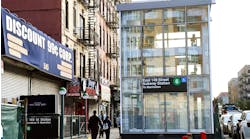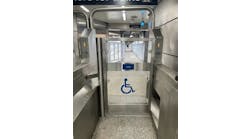CTA completes $18.2 million modernization of Quincy L station
Work to modernize the Chicago Transit Authority’s (CTA) historic Quincy L station has been completed and the station is now vertically accessible to customers with disabilities. The city of Chicago and CTA have a shared commitment to make the entire rail system wheelchair accessible during the next 20 years.
The $18.2 million modernization, funded with local tax increment finance (TIF) funds, added two elevators to the station on either side of Wells Street on the south end of each platform. The elevators connect to the stationhouse for both the Inner Loop (Orange, Purple, Pink Lines) and Outer Loop (Brown Line) platforms. The station was built in 1897 and was designated a Chicago Landmark in 2017. In keeping with the historical look of the station, the elevator tower exteriors mimic patterns on the station’s historic railings.
“The Quincy L station has served riders for more than 120 years, providing customers with convenient access to and from Chicago’s downtown Loop, business district and tourist destinations,” said Chicago Mayor Rahm Emanuel. “The addition of these two new elevators extends the life of this historic station and makes it fully functional and accessible for all 21st century customers.”
Additionally, Quincy Station received various lighting upgrades, reconfigured stairs to improve passenger circulation, replaced its flooring with tile, added new HD security cameras and installed motorized doors that meet ADA guidelines.
“CTA is proud to work with the mayor to extend the life of the 19th century Quincy L station - one of our most historic, iconic stations – and make it fully functional and accessible for 21st century customers,” CTA President Carter said. “The Quincy station reflects our commitment to providing accessible, affordable and reliable transportation to for all riders.”
CTA trains and buses are 100 percent accessible and 103 of CTA’s 145 rail stations (71 percent) are accessible. In July, CTA released a blueprint for making the remaining 42 rail stations fully accessible during the next two decades. The All Stations Accessibility Program (ASAP) Strategic Plan outlines both short- and long-term station accessibility projects.

Mischa Wanek-Libman | Group Editorial Director
Mischa Wanek-Libman is director of communications with Transdev North America. She has more than 20 years of experience working in the transportation industry covering construction projects, engineering challenges, transit and rail operations and best practices.
Wanek-Libman has held top editorial positions at freight rail and public transportation business-to-business publications including as editor-in-chief and editorial director of Mass Transit from 2018-2024. She has been recognized for editorial excellence through her individual work, as well as for collaborative content.
She is an active member of the American Public Transportation Association's Marketing and Communications Committee and served 14 years as a Board Observer on the National Railroad Construction and Maintenance Association (NRC) Board of Directors.
She is a graduate of Drake University in Des Moines, Iowa, where she earned a Bachelor of Arts degree in Journalism and Mass Communication.



